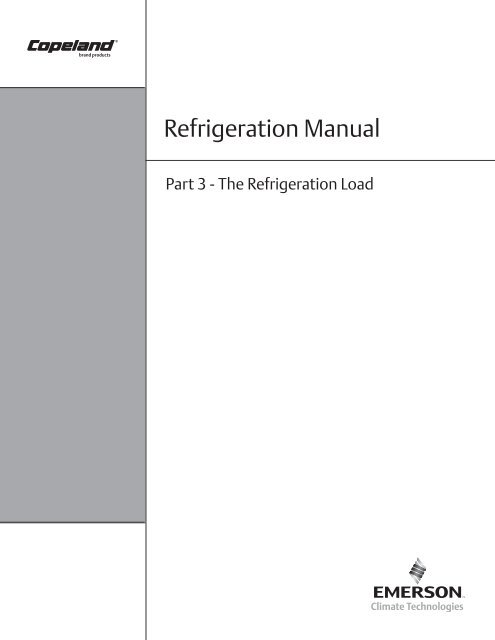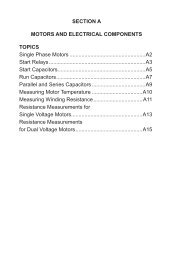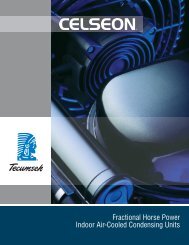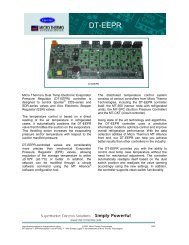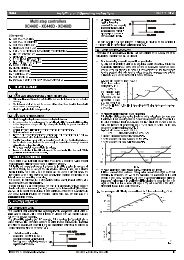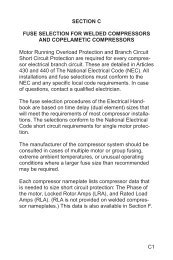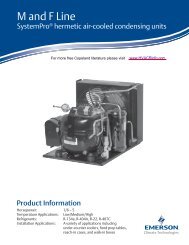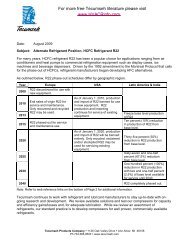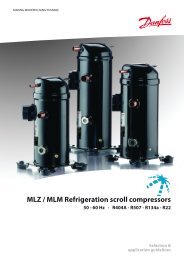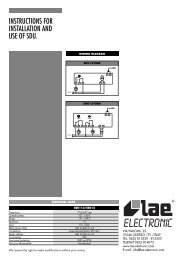The Refrigeration Load - HVAC and Refrigeration Information Links
The Refrigeration Load - HVAC and Refrigeration Information Links
The Refrigeration Load - HVAC and Refrigeration Information Links
You also want an ePaper? Increase the reach of your titles
YUMPU automatically turns print PDFs into web optimized ePapers that Google loves.
FOREWORD<strong>The</strong> practice of refrigeration undoubtedly goes back as far as the history of mankind, butfor thous<strong>and</strong>s of years the only cooling mediums were water <strong>and</strong> ice. Today refrigeration inthe home, in the supermarket, <strong>and</strong> in commercial <strong>and</strong> industrial usage is so closely woveninto our everyday existence it is difficult to imagine life without it. But because of this rapidgrowth, countless people who must use <strong>and</strong> work with refrigeration equipment do not fullyunderst<strong>and</strong> the basic fundamentals of refrigeration system operation.This manual is designed to fill a need which exists for a concise, elementary text to aidservicemen, salesman, students, <strong>and</strong> others interested in refrigeration. It is intended tocover only the fundamentals of refrigeration theory <strong>and</strong> practice. Detailed information as tospecific products is available from manufacturers of complete units <strong>and</strong> accessories. Usedto supplement such literature—<strong>and</strong> to improve general knowledge of refrigeration—thismanual should prove to be very helpful.© 1968 Emerson Climate Technologies, Inc.All rights reserved.
Part 3THE REFRIGERATION LOADSection 12. HEAT TRANSMISSIONTransmission Heat <strong>Load</strong> — Q........................... 12-1<strong>The</strong>rmal Conductivity — k................................. 12-1<strong>The</strong>rmal Resistivity — r..................................... 12-1Conductance — C............................................. 12-1<strong>The</strong>rmal Resistance — R.................................. 12-1Surface File Resistance.................................... 12-1Overall Coefficient of Heat Transfer — U.......... 12-1Transmission Heat <strong>Load</strong>................................... 12-2Values of <strong>The</strong>rmal Conductivity forBuilding Materials...................................... 12-3Outdoor Design Data........................................ 12-3Allowance for Radiation from the Sun............... 12-8Recommended Insulation Thickness................ 12-8Quick Calculation Table for Walk-in Coolers..... 12-9Section 13. AIR INFILTRATIONAir Change Estimating Method......................... 13-1Air Velocity Estimating Method......................... 13-1Ventilating Air.................................................... 13-2Infiltration Heat <strong>Load</strong>......................................... 13-2Section 14. PRODUCT LOADTables of Specific Product Data........................ 14-1Heat of Respiration........................................... 14-1Sensible Heat Above Freezing.......................... 14-7Latent Heat of Freezing.................................... 14-8Sensible Heat Below Freezing.......................... 14-8Total Product <strong>Load</strong>............................................ 14-8Storage Data..................................................... 14-8Section 15. SUPPLEMENTARY LOADElectric Lights <strong>and</strong> Heaters............................... 15-1Electric Motors.................................................. 15-1Human Heat <strong>Load</strong>............................................. 15-1Total Supplementary <strong>Load</strong>................................ 15-1Section 16. EQUIPMENT SELECTIONHourly <strong>Load</strong>....................................................... 16-1Sample <strong>Load</strong> Calculation.................................. 16-1Relative Humidity <strong>and</strong> Evaporator TD............... 16-2Compressor Selection....................................... 16-2Component Balancing....................................... 16-3<strong>The</strong> Effect of Change in CompressorOnly on System Balance........................... 16-9Quick Select Tables for Walk-in Coolers........... 16-11© 1968 Emerson Climate Technologies, Inc.All rights reserved.
INDEX OF TABLESTable 4 Typical Heat Transmission Coefficients.................................................................................. 12-3Table 5 Summer Outdoor Design Data............................................................................................... 12-5Table 6 Allowance for Sun Effect........................................................................................................ 12-8Table 7 Recommended Minimum Insulation Thickness...................................................................... 12-9Table 7A Quick Estimate Factors for Heat Transmission Through Insulated Walls............................... 12-9Table 8 Average Air Changes per 24 Hours for Storage Rooms Due to Opening <strong>and</strong> Infiltration....... 13-1Table 9 Heat Removed in Cooling Air to Storage Room Conditions................................................... 13-2Table 10 Food Products Data............................................................................................................... 14-1Table 11 Properties of Solids................................................................................................................ 14-4Table 12 Properties of Liquids............................................................................................................... 14-6Table 13 Storage Requirements <strong>and</strong> Properties of Perishable Products.............................................. 14-9Table 14 Storage Conditions for Cut Flowers <strong>and</strong> Nursery Stock......................................................... 14-11Table 15 Space, Weight, <strong>and</strong> Density Data for Commodities Stored in Refrigerated Warehouses...... 14-12Table 16 Heat Equivalent of Electric Motors......................................................................................... 15-1Table 17 Heat Equivalent of Occupancy............................................................................................... 15-1Table 18 Recommended Condensing Unit Capacity for Walk-in Coolers, 35°F. Temperature.............. 16-12Table 19 Recommended Condensing Unit Capacity for Walk-in Coolers, Low Temperature............... 16-12© 1968 Emerson Climate Technologies, Inc.All rights reserved.
Section 12HEAT TRANSMISSION<strong>The</strong> heat gain through walls, floors <strong>and</strong> ceilings will varywith the type of construction, the area exposed to a differenttemperature, the type of insulation, the thicknessof insulation, <strong>and</strong> the temperature difference betweenthe refrigerated space <strong>and</strong> the ambient air.In catalog <strong>and</strong> technical literature pertaining to heattransfer, certain letter symbols are commonly used todenote the heat transfer factors, <strong>and</strong> a working knowledgeof these symbols is frequently necessary to easilyinterpret catalog data.TRANSMISSION HEAT LOAD — Q<strong>The</strong> basic formula for heat transfer through some heattransfer barrier is:Q = U x A x TDQ = Heat transfer, BTU/HrU = Overall heat transfer coefficientBTU/(hour)(sq. ft.)(°F TD)A = Area in square feetTD = Temperature differential betweensides of thermal barrier, forexample, between outside designtemperature <strong>and</strong> the refrigeratedspace temperature.Q is the rate of heat flow, the quantity of heat flowingafter all factors are considered.THERMAL CONDUCTIVITY — k<strong>The</strong>rmal conductivity, k, is defined as the rate of heattransfer that occurs through a material in units ofBTU/(hr)(square foot of area)(°F TD) per inch of thickness.Different materials offer varying resistances tothe flow of heat.For example, the heat transfer in 24 hours through twosquare feet of material three inches in thickness havinga thermal conductivity factor of .25 with an averagetemperature difference across the material of 70°Fwould be calculated as follows:.25(k) x 2 sq. ft. x 24 hours x 70° TDQ = 3 inches thickness = 280 BTUSince the total heat transferred by conduction variesdirectly with time, area, <strong>and</strong> temperature difference, <strong>and</strong>varies inversely with the thickness of the material, it isreadily apparent that in order to reduce heat transfer,the thermal conductivity factor should be as small aspossible, <strong>and</strong> the material as thick as possible.THERMAL RESISTIVITY — r<strong>The</strong>rmal resistivity is defined as the reciprocal of thermalconductivity of 1/k. “r” is of importance because resistancevalues can be added numerically.R total = r 1+ r 2+ r 3Where r 1, r 2, <strong>and</strong> r 3are individual resistances. Thismakes the use of r convenient in calculating overallheat transfer coefficients.CONDUCTANCE — C<strong>The</strong>rmal conductance is similar to thermal conductivity,except that it is an overall heat transfer factor fora given thickness of material, as opposed to thermalconductivity, k, which is a factor per inch of thickness.<strong>The</strong> definition is similar, BTU/(hour)(square foot ofarea)(°F TD).THERMAL RESISTANCE — R<strong>The</strong>rmal resistance is the reciprocal of conductance, 1/Cin the same way that thermal resistivity is the reciprocalof conductivity.SURFACE FILM RESISTANCEHeat transfer through any material is affected by thesurface resistance to heat flow, <strong>and</strong> this is determinedby the type of surface, rough or smooth; its position,vertical or horizontal; its reflective properties; <strong>and</strong> therate of airflow over the surface. Surface film conductance,normally denoted by f ifor inside surfaces <strong>and</strong> f ofor outside surfaces is similar to conductance.However, in refrigeration work with insulated walls, theconductivity is so low that the surface film conductancehas little effect, <strong>and</strong> therefore, can be omitted from thecalculation.OVERALL COEFFICIENT OF HEATTRANSFER — U<strong>The</strong> overall coefficient of heat transfer, U, is defined asthe rate of heat transfer through a material or compoundstructural member with parallel walls. <strong>The</strong> U factor,as it is commonly called, is the resulting heat transfer12-1© 1968 Emerson Climate Technologies, Inc.All rights reserved.
VALUES OF THERMAL CONDUCTIVITY FORBUILDING MATERIALSExtensive testing has been done by many laboratoriesto determine accurate values for heat transfer throughall common building <strong>and</strong> structural materials. Certainmaterials have a high resistance to the flow of heat (alow thermal conductivity) <strong>and</strong> are therefore used asinsulation to decrease the heat transfer into the refrigeratedspace. <strong>The</strong>re are many different types of insulationsuch as asbestos, glass fiber, cork, reflective metals,<strong>and</strong> the new foam materials. Most good insulatingmaterials have a thermal conductivity (k) factor of approximately.25 or less, <strong>and</strong> rigid foam insulations havebeen developed with thermal conductivity (k) factors aslow as .12 to .15.Heat transmission coefficients for many commonly usedbuilding materials are shown in Table 4.OUTDOOR DESIGN DATAExtensive studies have been made of weather bureaurecords for many years to arrive at suitable outdoordesign temperatures. For air conditioning or refrigerationapplications, the maximum load occurs during thehottest weather.However, it is neither economical or practical to designequipment for the hottest temperature which might everoccur, since the peak temperature might occur for onlya few hours over the span of several years. <strong>The</strong>refore,the design temperature normally is selected as a temperaturethat will not be exceeded more than a givenpercentage of the hours during the four month summerseason. Table 5 lists summer design temperatures,which will be equaled or exceeded only during 1% ofthe hours during the four summer months.(continued on p. 12-8)12-3© 1968 Emerson Climate Technologies, Inc.All rights reserved.
© 1968 Emerson Climate Technologies, Inc.All rights reserved. 12-4
12-5© 1968 Emerson Climate Technologies, Inc.All rights reserved.
© 1968 Emerson Climate Technologies, Inc.All rights reserved. 12-6
12-7© 1968 Emerson Climate Technologies, Inc.All rights reserved.
ALLOWANCE FOR RADIATION FROM THE SUN<strong>The</strong> primary radiation factor involved in the refrigerationload is heat gain from the sun’s rays. If the walls of therefrigerated space are exposed to the sun, additionalheat will be added to the heat load. For ease in calculation,an allowance can be made for the sun load inrefrigeration calculations by increasing the temperaturedifferential by the factors listed in Table 6.This table is usable for refrigeration loads only, <strong>and</strong> isnot accurate for air conditioning estimates.RECOMMENDED INSULATION THICKNESSAs the desired storage temperature decreases, therefrigeration load increases, <strong>and</strong> as the evaporatingtemperature decreases, the compressor efficiencydecreases. <strong>The</strong>refore, from a practical <strong>and</strong> economicst<strong>and</strong>point, the insulation thickness must be increasedas the storage temperature decreases.Table 7 lists recommended insulation thickness from the1981 ASHRAE H<strong>and</strong>book of Fundamentals. <strong>The</strong> recommendationsare based on exp<strong>and</strong>ed polyurethane whichhas a conductivity factor of .16. If other insulations areused, the recommended thickness should be adjustedbase on relative k factors.© 1968 Emerson Climate Technologies, Inc.All rights reserved.12-8
QUICK CALCULATION TABLE FORWALK-IN COOLERSAs an aid in the quick calculation of heat transmissionthrough insulated walls, Table 7A lists the approximateheat gain in BTU per 1°F. temperature difference persquare foot of surface per 24 hours for various thicknessesof commonly used insulations. <strong>The</strong> thickness ofinsulation referred to is the actual thickness of insulation,<strong>and</strong> not the overall wall thickness.For example, to find the heat transfer for 24 hoursthrough a 6’ x 8’ wall insulated with 4 inches of glassfiber when the outside is exposed to 95°F ambienttemperature, <strong>and</strong> the box temperature is 0°F., calculateas follows:1.9 factor x 48 sq. ft. x 95°TD = 8664 BTU12-9© 1968 Emerson Climate Technologies, Inc.All rights reserved.
VENTILATING AIRIf positive ventilation is provided for a space by means ofsupply or exhaust fans, the ventilation load will replacethe infiltration load (if greater) <strong>and</strong> the heat gain may becalculated on the basis of the ventilating air volume.INFILTRATION HEAT LOADper cubic foot of infiltration as given in Table 9. For accuratecalculations at conditions not covered by Table9, the heat load can be determined by the differencein enthalpy between entering air <strong>and</strong> the storage roomair conditions. This is most easily accomplished by useof the psychrometric chart, which will be discussed indetail in a subsequent section.Once the rate of infiltration has been determined, theheat load can then be calculated from the heat gain13-2© 1968 Emerson Climate Technologies, Inc.All rights reserved.
© 1968 Emerson Climate Technologies, Inc.All rights reserved. 13-3
Section 14PRODUCT LOAD<strong>The</strong> product load is composed of any heat gain occurringdue to the product in the refrigerated space. <strong>The</strong>load may arise from a product placed in the refrigeratorat a temperature higher than the storage temperature,from a chilling or freezing process, or from the heat ofrespiration of perishable products. <strong>The</strong> total product loadis the sum of the various types of product load whichmay apply to the particular application.TABLES OF SPECIFIC PRODUCT DATA<strong>The</strong> following tables list data on specific products thatis essential in calculating the refrigeration product load.Table 10 covers food products, Table 11 solids, <strong>and</strong>Table 12 liquids.HEAT OF RESPIRATIONFruits <strong>and</strong> vegetables, even though they have beenremoved from the vine or tree on which they grew, arestill living organisms. <strong>The</strong>ir life processes continue forsome time after being harvested, <strong>and</strong> as a result theygive off heat. Certain other food products also undergocontinuing chemical reactions which produce heat.Meats <strong>and</strong> fish have no further life processes <strong>and</strong> donot generate any heat.<strong>The</strong> amount of heat given off is dependent on thespecific product <strong>and</strong> its storage temperature. Table 10lists various food products with pertinent storage data.Note that the heat of respiration varies with the storagetemperature.(continued on p. 14-7)14-1© 1968 Emerson Climate Technologies, Inc.All rights reserved.
© 1968 Emerson Climate Technologies, Inc.All rights reserved. 14-2
14-3© 1968 Emerson Climate Technologies, Inc.All rights reserved.
© 1968 Emerson Climate Technologies, Inc.All rights reserved. 14-4
14-5© 1968 Emerson Climate Technologies, Inc.All rights reserved.
© 1968 Emerson Climate Technologies, Inc.All rights reserved. 14-6
SENSIBLE HEAT ABOVE FREEZINGMost products are at a higher temperature than the storagetemperature when placed in a refrigerator. Sincemany foods have a high percentage of water content,their reaction to a loss of heat is quite different above<strong>and</strong> below the freezing point. Above the freezing point,the water exists in liquid form, while below the freezingpoint, the water has changed its state to ice.As mentioned previously, the specific heat of a productis defined as the BTUs required to raise the temperatureof one pound of the substance 1°F. <strong>The</strong> specific heatsof various commodities are listed in Tables 10, 11, <strong>and</strong>12. Note that in Table 10 the specific heat of the productabove freezing is different than the specific heat belowfreezing, <strong>and</strong> the freezing point (listed in the first column)varies, but in practically all cases is below 32°F.<strong>The</strong> heat to be removed from a product to reduce itstemperature above freezing may be calculated as follows:Q = W x c x (T 1- T 2)Q = BTU to be removedW = Weight of the product in poundsc = Specific heat above freezingT 1= Initial temperature, °F.T 2= Initial temperature, °F. (freezing or above)For example, the heat to be removed in order to cool1,000 pounds of veal (whose freezing point is 29°F.)from 42°F. to 29°F. can be calculated as follows:Q = W x c x (T 1- T 2)= 1000 pounds x .71 specific heat x (42-29)= 1000 x .71 x 13= 9,230 BTU14-7© 1968 Emerson Climate Technologies, Inc.All rights reserved.
LATENT HEAT OF FREEZING<strong>The</strong> latent heat of fusion or freezing for liquids otherthan water is given in Table 12. Substances such asmetals which contain no water do not have a freezingpoint, <strong>and</strong> no latent heat of fusion is involved in loweringtheir temperature.Most food products, however, have a high percentageof water content. In order to calculate the heat removalrequired to freeze the product, only the water need beconsidered. <strong>The</strong> water content percentage for variousfood products is given in Table 10, Column 2.Since the latent heat of fusion or freezing of water is 144BTU/lb., the latent heat of fusion for the product can becalculated by multiplying 144 BTU/lb. by the percentageof water content, <strong>and</strong> for ease in calculations this figureis given in Column 5 of Table 10. To illustrate, veal has awater percentage of 63%, <strong>and</strong> the latent heat of fusionlisted in Column 5 for veal is 91 BTU/lb.63% x 144 BTU/lb. = 91 BTU/lb.<strong>The</strong> heat to be removed from a product for the latentheat of freezing may be calculated as follows:Q = W x h ifQ = BTU to be removedW = Weight of product in poundsh if= latent heat of fusion, BTU/lb.<strong>The</strong> latent heat of freezing of 1000 pounds of veal at29°F. is:Q = W x h if= 1000 lbs. x 91 BTU/lb.= 91,000 BTUSENSIBLE HEAT BELOW FREEZINGOnce the water content of a product has been frozen,sensible cooling again can occur in the same manneras that above freezing, with the exception that the ice inthe product causes the specific heat to change. Note inTable 10 the specific heat of veal above freezing is .71,while the specific heat below freezing is .39,Q = BTU to be removedW = Weight of product in poundsc i= Specific heat below freezingT f= Freezing temperatureT 3= Final temperatureFor example, the heat to be removed in order to cool1,000 pounds of veal from 29°F. to 0°F. can be calculatedas follows:Q = W x c ix (T f- T 3)= 1,000 lbs. x .39 specific heat x (29-0)= 1,000 x .39 x 29= 11,310 BTUTOTAL PRODUCT LOAD<strong>The</strong> total product load is the sum of the individualcalculations for the sensible heat above freezing, thelatent heat of freezing, <strong>and</strong> the sensible heat belowfreezing.From the foregoing example, if 1,000 pounds of veal isto be cooled from 42°F. to 0°F., the total would be:Sensible Heat above Freezing 9,230 BTULatent Heat of Freezing 91,000 BTUSensible Heat Below Freezing 11,310 BTUTotal Product <strong>Load</strong> 111,540 BTUIf several different commodities or crates, baskets, etc.are to be considered, then a separate calculation mustbe made for each item for an accurate estimate of theproduct load.STORAGE DATAMost commodities have conditions of temperature <strong>and</strong>relative humidity at which their quality is best preserved<strong>and</strong> their storage life is a maximum. Recommended storageconditions for various perishable products are listedin Table 13 <strong>and</strong> recommended storage conditions for cutflowers <strong>and</strong> nursery stock are listed in Table 14.Data on various types of storage containers is listedin Table 15.<strong>The</strong> heat to be removed from a product to reduce its temperaturebelow freezing may be calculated as follow:Q = W x c ix (T f- T 3)© 1968 Emerson Climate Technologies, Inc.All rights reserved.14-8
14-9© 1968 Emerson Climate Technologies, Inc.All rights reserved.
© 1968 Emerson Climate Technologies, Inc.All rights reserved.14-10
14-11© 1968 Emerson Climate Technologies, Inc.All rights reserved.
© 1968 Emerson Climate Technologies, Inc.All rights reserved.14-12
14-13© 1968 Emerson Climate Technologies, Inc.All rights reserved.
Section 15SUPPLEMENTARY LOADIn addition to the heat transmitted into the refrigeratedspace through the walls, air infiltration, <strong>and</strong> product load,any heat gain from other sources must be included inthe total cooling load estimate.ELECTRIC LIGHTS AND HEATERSAny electric energy directly dissipated in the refrigeratedspace such as lights, heaters, etc. is converted to heat<strong>and</strong> must be included in the heat load. One watt hourequals 3.41 BTU, <strong>and</strong> this conversion ratio is accuratefor any amount of electric power.ELECTRIC MOTORSTOTAL SUPPLEMENTARY LOAD<strong>The</strong> total supplementary load is the sum of the individualfactors contributing to it. For example, the total supplementaryload in a refrigerated storeroom maintained at0°F. in which there are 300 watts of electric lights, a 3HP motor driving a fan, <strong>and</strong> 2 people working continuouslywould be as follows:300 Watts x 3.41 BTU/hr. 1,023 BTU/hr.3 HP motor x 2,950 BTU/hr. 8,850 BTU/hr.2 people x 1300 BTU/hr. 2,600 BTU/hr.Total Supplementary <strong>Load</strong> 12,473 BTU/hr.Since energy cannot be destroyed, <strong>and</strong> can only bechanged to a different form, any electrical energytransmitted to motors inside a refrigerated space mustundergo a transformation. Any motor losses due to friction<strong>and</strong> inefficiency are immediately changed to heatenergy. That portion of the electrical energy convertedinto useful work, for example in driving a fan or pump,exists only briefly as mechanical energy, is transferredto the fluid medium in the form of increased velocity, <strong>and</strong>as the fluid loses its velocity due to friction, eventuallybecomes entirely converted into heat energy.A common misunderst<strong>and</strong>ing is the belief that no heatis transmitted into the refrigerated space if an electricmotor is located outside the space, <strong>and</strong> a fan inside thespace is driven by means of a shaft. All of the electricalenergy converted to mechanical energy actually becomesa part of the load in the refrigerated space.Because the motor efficiency varies with size, the heatload per horsepower as shown in Table 16 has differentvalues for varying size motors. While the values in thetable represent useful approximations, the actual electricpower input in watts is the only accurate measureof the energy input.HUMAN HEAT LOADPeople give off heat <strong>and</strong> moisture, <strong>and</strong> the resultingrefrigeration load will vary depending on the duration ofoccupancy of the refrigerated space, temperature, typeof work, <strong>and</strong> other factors. Table 17 lists the averagehead load due to occupancy, but stays of short duration,the heat gain will be somewhat higher.© 1968 Emerson Climate Technologies, Inc.All rights reserved.15-1
Section 16EQUIPMENT SELECTIONOnce the refrigeration load is determined, together withthe required evaporating temperature <strong>and</strong> the expectedcondensing temperature, a compressor can be intelligentlyselected for a given application.For refrigerated fixtures or prefabricated coolers <strong>and</strong>cold storage boxes to be produced in quantity, theload is normally determined by test. If the load mustbe estimated, the expected load should be calculatedby determining the heat gain due to each of the factorscontributing to the total load. Many short methods ofestimating are commonly used for small refrigeratedwalk-in storage boxes with varying degrees of accuracy.A great deal of judgment must be used in the applicationof any method.HOURLY LOAD<strong>Refrigeration</strong> equipment is designed to function continuously,<strong>and</strong> normally the compressor operating time is determinedby the requirements of the defrost system. <strong>The</strong>load is calculated on a 24 hour basis, <strong>and</strong> the requiredhourly compressor capacity is determined by dividingthe 24 hour load by the desired hours of compressoroperation during the 24 hour period. A reasonable safetyfactor must be provided to enable the unit to recoverrapidly after a temperature rise, <strong>and</strong> to allow for loadingheavier than the original estimate.When the refrigerant evaporating temperature will not bebelow 30°F., frost will not accumulate on the evaporator,<strong>and</strong> no defrost period is necessary. It is general practiceto choose the compressor for such applications on thebasis of 18 to 20 hour operation.For applications with storage temperatures of 35°F.or higher, <strong>and</strong> refrigerant temperatures low enough tocause frosting, it is common practice to defrost by stoppingthe compressor <strong>and</strong> allowing the return air to meltthe ice from the coil. Compressors for such applicationsshould be selected for 16 to 18 hour operation.On low temperature applications, some positive meansof defrost must be provided. With normal defrost periods,18 hour compressor operation is usually acceptable,although some systems are designed for continuousoperation except during the defrost period.An additional 5% to 10% safety factor is often added toload calculations as a conservative measure to be surethe equipment will not be undersized. If data concerningthe refrigeration load is very uncertain, this may be desirable,but in general the fact that the compressor is sizedon the basis of 16 to 18 hour operation in itself providesa sizable safety factor. <strong>The</strong> load should be calculatedon the basis of the peak dem<strong>and</strong> at design conditions,<strong>and</strong> normally the design conditions are selected on thebasis that they will occur no more that 1% of the hoursduring the summer months. If the load calculations aremade reasonably accurately, <strong>and</strong> the equipment sizedproperly, an additional safety factor may actually resultin the equipment being oversized during light load conditions,<strong>and</strong> can result in operating difficulties.SAMPLE LOAD CALCULATION<strong>The</strong> most accurate means of estimating a refrigerationload is by considering each factor separately. <strong>The</strong> followingexample will illustrate a typical selection procedure,although the load has been chosen to demonstrate thecalculations required <strong>and</strong> does not represent a normalloading.Walk-in cooler with 4 inches of glass fiber insulation,located in the shade.Outside Dimensions, Height 8 ft., Width 10 ft.,Length 40 ft., inside volume 3,000 cu. ft.Floor area (outside dimensions) 400 sq. ft. on insulatedslab in contact with ground.Ambient temperature 100°F., 50% relative humidityGround temperature 55°F.Refrigerator temperature 40°F.1/2 HP fan motor running continuouslyTwo 100 watt lights, in use 12 hours per day.Occupancy, 2 men for 2 hours per day.In storage:500 pounds of bacon at 50°F.1000 pounds of string beansEntering product:500 pounds of bacon at 50°F.15,000 pounds of beer at 80°F.To be reduced to storage temperaturein 24 hours.Heavy door usage.16-1© 1968 Emerson Climate Technologies, Inc.All rights reserved.
(A)HEAT TRANSMISSION LOAD(E) REQUIRED COMPRESSOR CAPACITYSidewalls:40’ x 8’ x 2 = 640 Ft 2 x60°TD x 1.9 (Table 7A)= 72,960 BTU10’ x 8’ x 2 = 160 Ft 2 x60°TD x 1.9 = 18,240Ceiling:40’ x 10’ = 400 Ft 2 x 60°TDx 1.9 = 45,600Floor:40’ x 10’ = 400 Ft 2 x 15°TDx 1.9 = 11,400Total 24 hour transmission load = 148,200(B) AIR INFILTRATION3000 Ft 3 x 9.5 air changes(Table 8) x 2 usage factor x2.11 factor (Table 9) 120,270 BTU(C) PRODUCT LOAD500 lbs. bacon x .50 sp.ht. (Table 10) x 10°TD = 2,500 BTU15,000 lbs. beer x 1.0 sp. ht.(Table 10) x 40°TD = 600,000 BTU500 lbs. lettuce x 2700BTU/24 Hr/Ton (Table 10) =675 BTU1,000 lbs. beans x 9700BTU/24 Hr/Ton (Table 10) = 4,850 BTUTotal 24 hour Product <strong>Load</strong> 608,025 BTU(D) SUPPLEMENTARY LOAD24 Hour <strong>Load</strong>:Heat Transmission148,200 BTUAir Infiltration 120,270Product 608,025Supplementary 62,544Total 24 Hour <strong>Load</strong> 939,039 BTURequired compressor capacity:Based on 16 hour operation58,690 BTU/Hr.RELATIVE HUMIDITY AND EVAPORATOR TDRelative humidity in a storage space is affected bymany variables, such as system running time, moistureinfiltration, condition <strong>and</strong> amount of product surface exposed,air motion, outside air conditions, type of systemcontrol, etc. Perishable products differ in their requirementsfor an optimum relative humidity for storage, <strong>and</strong>recommended storage conditions for various productsare shown in Tables 13 <strong>and</strong> 14. Normally satisfactorycontrol of relative humidity in a given application can beachieved by selecting the compressor <strong>and</strong> evaporatorfor the proper operating temperature difference or TDbetween the desired room temperature <strong>and</strong> the refrigerantevaporating temperature.<strong>The</strong> following general recommendations have provento be satisfactory in most normal applications:DesiredTDTemperature Relative (RefrigerantRange Humidity to Air)25°F. to 45°F. 90% 8°F. to 12°F.25°F. to 45°F. 85% 10°F. to 14°F.25°F. to 45°F. 80% 12°F. to 16°F.25°F. to 45°F. 75% 16°F. to 22°F.10°F. <strong>and</strong> below — 15°F. or less200 Watts x 12 hours x 3.41BTU/Hr1/2 H.P. x 4250 BTU/Hr-Hr(Table 16) x 242 People x 2 Hrs/Day x 840BTU/Hr (Table 17)Total 24 hour Supplementary<strong>Load</strong>8,184 BTU51,000 BTU3,360 BTU62,544 BTUCOMPRESSOR SELECTIONIn order to select a suitable compressor for a givenapplication, not only the required compressor capacitymust be known, but also the desired evaporating <strong>and</strong>condensing temperatures.Assuming a desired relative humidity of 80%, a 14° TDmight be used, which in a 40°F. storage room resultin evaporating temperature of 26°F. To provide somesafety factor for line losses, the compressor should beselected for the desired capacity at 2°F. to 3°F. belowthe desired evaporating temperature.© 1968 Emerson Climate Technologies, Inc.All rights reserved.16-2
<strong>The</strong> condensing temperature depends on the type ofcondensing medium to be used, air or water, the designambient temperature or water temperature, <strong>and</strong> thecapacity of the condenser selected. Air cooled condensersare commonly selected to operate on temperaturedifferences (TD) from 10°F. to 30°F. the lower TD normallybeing used for low temperature applications, <strong>and</strong>higher TDs for high temperature applications where thecompression ratio is less critical. For the purposes ofthis example, a design TD of 20°F. has been selected,<strong>and</strong> in 100°F. ambient temperatures, this would resultin a condensing temperature of 120°F.COMPONENT BALANCINGCommercially available components seldom will exactlymatch the design requirements of a given system, <strong>and</strong>since system design is normally based on estimatedpeak loads, the system may often have to operate atconditions other than design conditions. More thanone combination of components may meet the performancerequirements, the efficiency of the systemnormally being dependent on the point at which thesystem reaches stabilized conditions or balances underoperating conditions.<strong>The</strong> capacities of each of the three major systemcomponents, the compressor, the condenser, <strong>and</strong> theevaporator, are each variable but interrelated. <strong>The</strong>compressor capacity varies with the evaporating <strong>and</strong>condensing temperatures. For illustration purposes anair cooled condenser will be considered, <strong>and</strong> for a givencondenser with constant air flow, its capacity will varywith the temperature difference between the condensingtemperature <strong>and</strong> the ambient temperature.<strong>The</strong> factors involved in the variation in evaporator capacityare quite complex when both sensible heat transfer<strong>and</strong> condensation are involved. For component balancingpurposes, the capacity of an evaporator whereboth latent <strong>and</strong> sensible heat transfer are involved (awet coil) may be calculated as being proportional to thetotal heat content of the entering air, <strong>and</strong> this in turn isproportional to the wet bulb temperature. For wet coilconditions, evaporator capacities are normally availablefrom coil manufacturers with ratings based on the wetbulb temperature of the air entering the coil. For conditionsin which no condensation occurs (a dry coil) theevaporator capacity can be accurately estimated onthe basis of the dry bulb temperature of the air enteringthe coil.Some manufacturers of commercial <strong>and</strong> low temperaturecoils publish only ratings based on the temperaturedifference between entering dry bulb temperature <strong>and</strong>the evaporating refrigerant temperature. Although frostaccumulation involving latent heat will occur, unless thelatent load is unusually large, the dry bulb ratings maybe used without appreciable error.Because of the many variables involved, the calculationof system balance points is extremely complicated. Asimple, accurate, <strong>and</strong> convenient method of forecastingsystem performance from readily available manufacturer’scatalog data is the graphical construction ofa component balancing chart. <strong>The</strong> following exampleillustrates the use of such a chart in checking the possiblebalance points of a system when selecting equipment.To illustrate the procedure, tentative selectionsof a compressor, condenser, <strong>and</strong> evaporator have beenmade for the sample load previously calculated.Figure 69 shows the compressor capacity curves aspublished by Emerson Climate Technologies, Inc. onthe Copel<strong>and</strong>® br<strong>and</strong> compressor specification sheet.It should be noted that Copel<strong>and</strong>® br<strong>and</strong> compressorcapacity curves for Copelametic® compressors arebased on 65°F. return suction gas. In order to realize thefull compressor capacity, the suction gas must be raisedto this temperature in a heat exchanger. If the suctiongas returns to the compressor at a lower temperature,or if the increase in suction gas temperature occurs dueto heat transfer into the suction line outside the refrigeratedspace, the effective compressor capacity will besomewhat lower. In the example, the desired capacitywas 58,690 BTU/hr. at 24°F. evaporating temperature<strong>and</strong> 120°F.condensing temperature, <strong>and</strong> this compressorwas the closest choice available, having a capacityof 57,000 BTU/hr. at the design conditions.Figure 70 shows the same compressor curves, withthe condenser capacity curves for the tentative condenserselection superimposed. From the condensermanufacturer’s data, condenser capacity in terms ofcompressor capacity at varying evaporating temperaturesare plotted, <strong>and</strong> the condenser capacity curves canthen be drawn. Note that the net condensing capacitydecreases at lower evaporating temperatures due tothe increased heat of compression.It is now possible to construct balance lines for the compressor<strong>and</strong> condenser at various ambient temperaturesas shown in Figure 71. For an ambient temperatureof 100°F., point A would represent the balance pointif the compressor were operating at a suction pressureequivalent to a 28°F. evaporating temperature<strong>and</strong> 120°F. condensing temperature. At this point thecapacity of the condenser would exactly match that ofthe compressor at a 20° TD (condensing temperatureminus ambient temperature). <strong>The</strong> balance point is determinedby the intersection of the 20°F. TD condensercapacity curve with the compressor capacity curve for(continued on p. 16-9)16-3© 1968 Emerson Climate Technologies, Inc.All rights reserved.
© 1968 Emerson Climate Technologies, Inc.All rights reserved.16-4
CONDENSER CAPACITY CURVES SUPERIMPOSEDON COMPRESSOR CAPACITY CURVES16-5© 1968 Emerson Climate Technologies, Inc.All rights reserved.
© 1968 Emerson Climate Technologies, Inc.All rights reserved.16-6
16-7© 1968 Emerson Climate Technologies, Inc.All rights reserved.
© 1968 Emerson Climate Technologies, Inc.All rights reserved.16-8
a condensing temperature 20°F above the specifiedambient temperature of 100°F., or 120°F. In a similarmanner balance point B can be located by the intersectionof the 25°F. TD condenser capacity curve <strong>and</strong>the compressor capacity curve (estimated) for 125°F.condensing, <strong>and</strong> balance point C can be located by theintersection of the 15°F. TD condenser capacity curvewith the compressor capacity curve (estimated) for115°F. condensing. <strong>The</strong> line connecting points A, B, <strong>and</strong>C represents all the possible balance points when thesystem is operating with air entering the condenser at atemperature of 100°F. In a similar fashion, condensercompressorbalance lines can be determined for otherambient temperatures, <strong>and</strong> plotted as shown in Figure72. (To simplify the illustration, condenser capacitycurves have not been shown)<strong>The</strong> tentative evaporator coil selected was rated bythe manufacturer only in terms of BTU/hr per degreetemperature difference between the entering dry bulbtemperature <strong>and</strong> the refrigerant evaporating temperature,<strong>and</strong> have a capacity of 4,590 BTU/hr/°TD. In Figure73 evaporator capacity curves have been plotted <strong>and</strong>superimposed on the compressor capacity curves <strong>and</strong>the condenser-compressor balance lines. An evaporatorcapacity curve for each entering air temperature can beconstructed by plotting any two points.Point A represents the evaporator capacity at 14°TDwhich for an entering air temperature of 40°F. wouldrequire a refrigerant evaporating temperature of 26°F.However, an allowance must be made for line frictionlosses since the pressure in the evaporator will alwaysbe higher than the suction pressure at the compressorbecause of pressure drop in the suction line. Allowing2°F. as an estimated allowance for line pressure drop,an evaporating temperature of 26°F. would result in apressure at the compressor equivalent to a saturatedevaporating temperature of 24°F. <strong>The</strong>refore the capacityof the evaporator for a 14° TD <strong>and</strong> 40°F. enteringair would be plotted at the corresponding compressorcapacity at 24°F.Point B represents the evaporator capacity at 10°TD, which for 40°F. entering air temperature requiresa refrigerant evaporating temperature of 30°F., <strong>and</strong>after allowing for suction line losses, a correspondingcompressor capacity at 28°F. A line can then be drawnthrough these two points, representing all possiblecapacities of the evaporator with 40°F. entering air<strong>and</strong> varying refrigerant evaporating temperatures. In asimilar fashion, capacity curves can be constructed forother entering air temperatures.<strong>The</strong> system performance can now be forecast for anycondition of evaporator entering air temperature <strong>and</strong>ambient temperature. With 100°F. ambient temperature<strong>and</strong> an evaporator entering air temperature of 40°F.,the original design conditions, the system would havea capacity of 59,000 BTU/hr, a compressor suctionpressure equivalent to an evaporating temperature of26°F., <strong>and</strong> a condensing temperature of 120°F. Evenunder extreme load conditions of 50°F. entering air <strong>and</strong>110°F. ambient, the condensing temperature would notexceed 133°F. <strong>The</strong>se conditions are close enough tothe original design requirement to insure satisfactoryperformance.This type of graphical analysis can be quickly <strong>and</strong> easilymade by using the compressor specification sheetas the basic chart, <strong>and</strong> superimposing condenser <strong>and</strong>evaporator capacity curves.THE EFFECT OF CHANGE IN COMPRESSORONLY ON SYSTEM BALANCEOccasionally the exact replacement compressor maynot be available, <strong>and</strong> the question arises as to whetheran alternate compressor with either more or less capacitymight provide satisfactory performance. <strong>The</strong>graphical balance chart provides a convenient meansof forecasting system performance.Figure 74 is a revised balance chart for a system utilizingthe same evaporator <strong>and</strong> condenser as in the previousexample, but with a compressor having only 5/6 of theprevious capacity. New compressor capacity curves forthe smaller compressor have been plotted on the samecapacity chart used previously. Since there is no changein the basic capacity of the condenser or evaporator,the condenser capacity <strong>and</strong> evaporator capacity curvesare unchanged.However, a new compressor-condenser balance linemust be plotted, <strong>and</strong> to avoid excessive detail in the illustration,a balance line for 100° ambient temperatureonly has been shown.A comparison can now be made between the systemwith the original compressor, Figure 73, <strong>and</strong> the systemwith the smaller compressor, Figure 74.Original RevisedSystem SystemAmbient Temperature 100°F. 100°F.Air Entering Evaporator 40°F. 40°F.Refrigerant EvaporatingTemp. 26°F. 27°F.Condensing Temperature 120°F. 115°F.Capacity at 100°F. Ambient<strong>and</strong> 40°F. Entering Air,BTU/hr. 59,000 53,000(continued on p. 16-11)16-9© 1968 Emerson Climate Technologies, Inc.All rights reserved.
© 1968 Emerson Climate Technologies, Inc.All rights reserved.16-10
Note that although the compressor capacity was decreasedby 1/6 or 16 2/3%, the net system capacitydecreased only about 10%. Since the condenser <strong>and</strong>evaporator were unchanged, the compressor couldoperate at more efficient conditions, with decreasedcondensing pressure <strong>and</strong> increased suction pressure.<strong>The</strong> same type of analysis can be applied to determinethe effect on system capacity if the compressor on aunit designed for 60 cycle operation is operated on 50cycle power. However for the evaporator <strong>and</strong> condensercapacity to remain constant, the air flow across bothevaporator <strong>and</strong> condenser must be unchanged. If theoriginal balance chart was made on the basis of fansoperating on 60 cycle power, <strong>and</strong> the fan air delivery isdecreased by operation of the fan motors on 50 cyclepower, then both the evaporator <strong>and</strong> condenser capacitycurves must be changed to reflect the decrease incapacity.Another type of application where this type of analysismay be valuable is on systems with fluctuating loads<strong>and</strong> compressors with capacity control features. Sincethe evaporator <strong>and</strong> condenser remain unchanged, thereduced compressor capacity can be plotted as demonstrated,<strong>and</strong> new balance points determined, takinginto effect any changes in the temperature of the airentering the evaporator.QUICK SELECTION TABLES FOR WALK-INCOOLERS<strong>The</strong> most accurate means of determining the refrigerationload is by calculating each of the factors contributingto the load as was done in the previous example. However,for small walk-in coolers, various types of shortcut estimating methods are frequently used.<strong>The</strong> transmission load will always be dependent on theexternal surface, <strong>and</strong> an actual calculation should bemade where possible.As an aid in rapid selection of a condensing unit for thenormal walk-in cooler application, Tables 19 <strong>and</strong> 20 giverecommended refrigeration capacities for various sizedcoolers. <strong>The</strong> condensing unit capacity must be equalto or greater than the capacity shown at the requiredrefrigerant evaporating temperature after allowance forthe desired evaporating <strong>and</strong> condensing TD.<strong>The</strong> capacities given are for average applications. If theload is unusual, these tables should not be used. <strong>The</strong>low temperature tables do not include any allowancefor a freezing load, <strong>and</strong> if a product is to be frozen, additionalcapacity will be required.16-11© 1968 Emerson Climate Technologies, Inc.All rights reserved.
Table 18Table 19© 1968 Emerson Climate Technologies, Inc.All rights reserved.16-12
16-13© 1968 Emerson Climate Technologies, Inc.All rights reserved.
Form No. AE 103 R3 (10/06)Emerson®, Emerson. Consider It Solved, Emerson Climate Technologies <strong>and</strong>the Emerson Climate Technologies logo are the trademarks <strong>and</strong> service marks ofEmerson Electric Co. <strong>and</strong> are used with the permission of Emerson Electric Co.Copelametic®, Copel<strong>and</strong>®, <strong>and</strong> the Copel<strong>and</strong>® br<strong>and</strong> products logo are thetrademarks <strong>and</strong> service marks of Emerson Climate Technologies, Inc.All other trademarks are the property of their respective owners.Printed in the USA. © 1968 Emerson Climate Technologies, Inc. All rights reserved.1675 W. Campbell Rd.Sidney, OH 45365EmersonClimate.com


